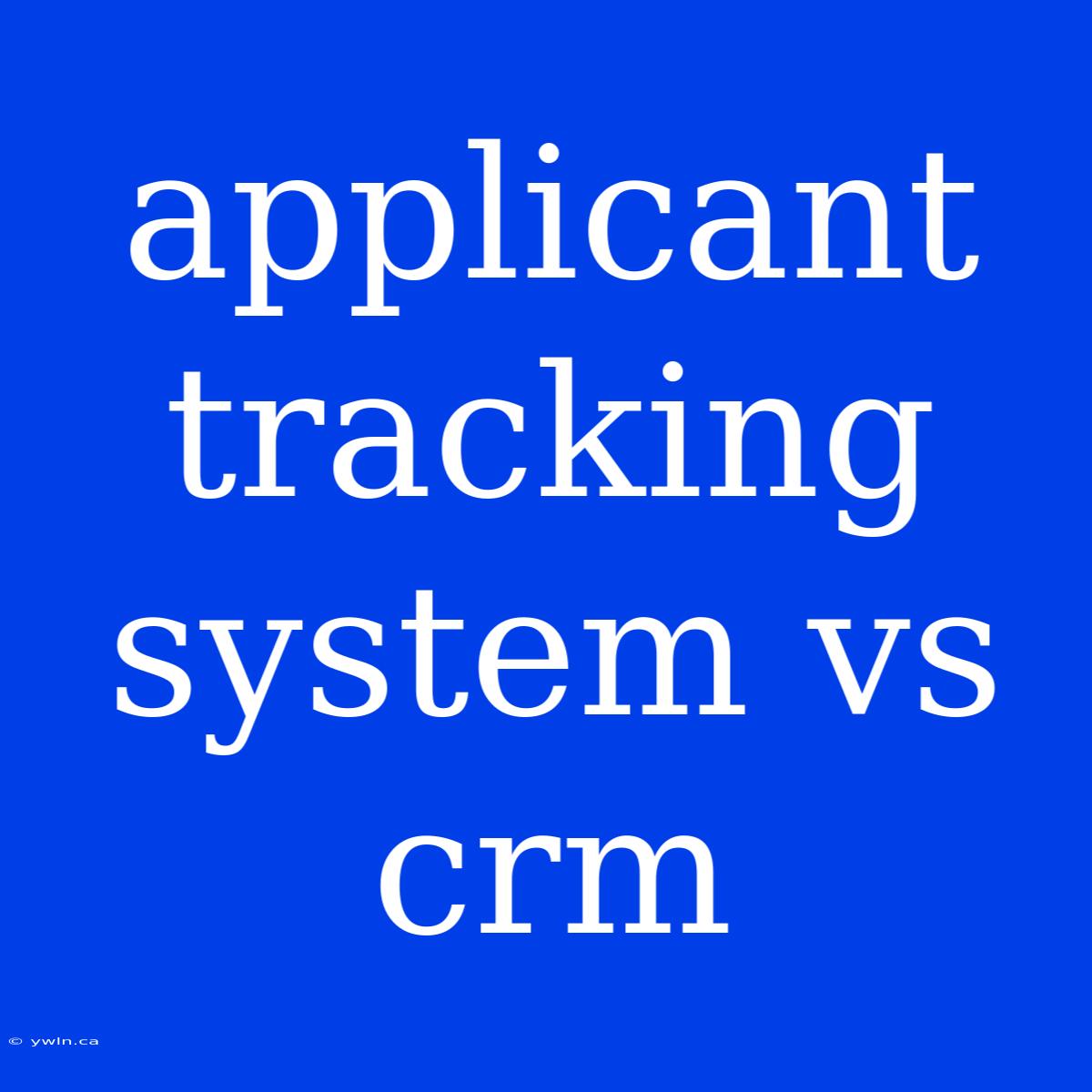Applicant Tracking System vs CRM: Unlocking the Secrets to Talent Acquisition and Customer Management
Is it an Applicant Tracking System (ATS) or a CRM that's the key to your company's success? The answer depends on your focus: talent acquisition or customer management? Both systems are powerful tools, but their purposes differ significantly. This article will provide a clear understanding of each system, highlighting their strengths and drawbacks to help you make an informed decision.
Editor Note: This article dives into the often-confused world of ATS and CRM. You'll learn how to identify the right system for your organization's needs and how to maximize their potential.
Analysis: This analysis examines the core features and functionalities of ATS and CRM systems, exploring their differences and their impact on your business processes. We've researched and compared industry-leading solutions to provide you with a comprehensive understanding of each platform.
Key Takeaways:
| Feature | Applicant Tracking System (ATS) | Customer Relationship Management (CRM) |
|---|---|---|
| Focus | Talent Acquisition | Customer Management |
| Primary Users | Recruiters, HR Professionals | Sales, Marketing, Customer Support |
| Data Management | Applicant profiles, job applications, resumes | Customer profiles, interactions, sales opportunities |
| Key Functions | Sourcing, screening, interviewing, onboarding | Lead generation, nurturing, sales management, customer service |
Applicant Tracking System (ATS)
Introduction: An ATS is a specialized software designed to streamline the recruitment process, from sourcing candidates to onboarding new hires. This system helps companies manage large volumes of applications, automate tasks, and ultimately improve the efficiency of their hiring process.
Key Aspects:
- Sourcing: An ATS helps you find potential candidates through job boards, social media, and other platforms.
- Screening: ATS systems use sophisticated algorithms to filter applications based on keywords, skills, and experience.
- Communication: The ATS facilitates communication with candidates, scheduling interviews, and sending automated emails.
- Tracking: The system tracks candidate progress throughout the recruitment process, providing valuable insights into your hiring efficiency.
- Onboarding: Some ATS systems offer onboarding features to help new hires get acclimated to the company culture and their new role.
Discussion: An ATS excels at simplifying the complex recruitment process. By automating tasks like resume parsing and candidate screening, it allows recruiters to focus on building relationships with potential employees. It also provides data-driven insights into hiring trends, enabling companies to optimize their strategies.
Customer Relationship Management (CRM)
Introduction: A CRM is a system that helps businesses manage their interactions with customers and potential customers. It centralizes customer data, enabling sales, marketing, and customer support teams to create personalized experiences and build stronger relationships.
Key Aspects:
- Lead Generation: CRMs help you identify and capture leads through various channels, such as websites, social media, and events.
- Nurturing: The system helps you nurture leads through automated emails, personalized content, and other engagement strategies.
- Sales Management: CRMs track sales opportunities, manage pipelines, and provide insights into sales performance.
- Customer Service: CRMs can facilitate communication with customers, track support tickets, and resolve issues efficiently.
- Analytics: CRMs provide valuable data on customer behavior, enabling companies to understand their target audience and tailor their strategies accordingly.
Discussion: A CRM is essential for companies that want to build strong customer relationships and drive sales. By centralizing customer data and automating tasks, it empowers businesses to create personalized experiences, increase customer loyalty, and ultimately boost revenue.
FAQ
Introduction: This section addresses common questions regarding ATS and CRM systems.
Questions:
-
What are the main differences between ATS and CRM?
- An ATS focuses on talent acquisition, while a CRM concentrates on customer management.
-
Can I use both an ATS and a CRM?
- Yes, many businesses use both systems to optimize their recruitment and customer management processes.
-
What are some popular ATS and CRM solutions?
- Popular ATS solutions include Greenhouse, Workday, and Taleo. Leading CRMs include Salesforce, HubSpot, and Zoho.
-
How do I choose the right system for my business?
- Consider your specific needs and prioritize the features that are most relevant to your goals.
-
What are the costs associated with ATS and CRM systems?
- The costs vary depending on the chosen solution and the number of users. Many systems offer different pricing tiers and subscription models.
-
How can I integrate an ATS and CRM?
- Many ATS and CRM systems offer integration capabilities that allow you to share data and automate workflows between them.
Summary: Both ATS and CRM systems offer valuable features to streamline business processes. However, they serve different purposes and target different audiences. Choosing the right system depends on your company's priorities and specific needs.
Tips
Introduction: Here are some tips for effectively using ATS and CRM systems:
Tips:
- Clearly Define Your Goals: Identify the specific challenges you want to address with an ATS or CRM.
- Choose the Right System: Carefully evaluate different solutions to find one that fits your needs and budget.
- Customize and Configure: Take advantage of the system's customization options to create workflows and reports that suit your processes.
- Train Your Team: Ensure your team is properly trained on the system's features and functionalities.
- Regularly Monitor and Analyze: Utilize the system's reporting capabilities to track progress and make informed decisions.
Summary
This article explored the key differences between ATS and CRM systems, providing a comprehensive overview of their features, benefits, and applications. By understanding these distinctions, you can make informed decisions about which system is best suited for your business needs.
Closing Message: Investing in the right technology can significantly enhance your talent acquisition and customer management strategies. By leveraging the power of ATS and CRM systems, you can streamline your processes, improve efficiency, and achieve greater success.

